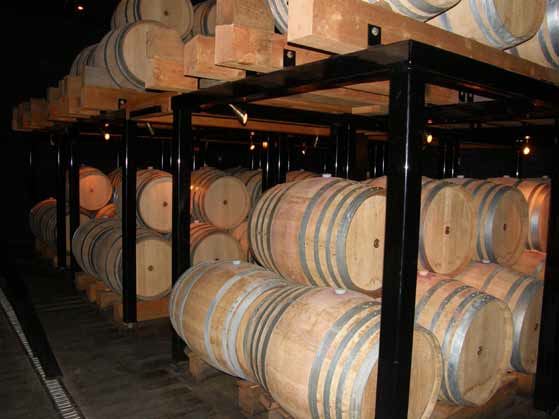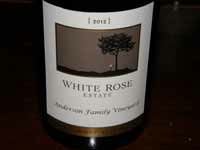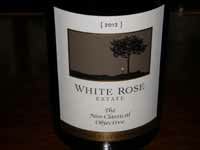White Rose Estate: Pursuing a Neo-Classical Objective
The owner and producer at White Rose Estate, Greg Sanders, acquired the 10-acre White Rose Vineyard in
the Dundee Hills in the summer of 2000. A few years prior, having found satisfaction as the owner of a
moderately large manufacturing company in Los Angeles, Greg began to look for something that offered an
emotional connection and found it in wine. Since he was not one to do things a little bit as he put it, he began
an exhaustive exploration of Pinot Noir wines, beginning with ones from California, then Burgundy and Oregon.
He tasted all the well-known labels and studied the wines in depth to learn what made them special and what
allowed them to age. Eventually he arrived at an “aha!” moment and decided the key was an old vine vineyard.
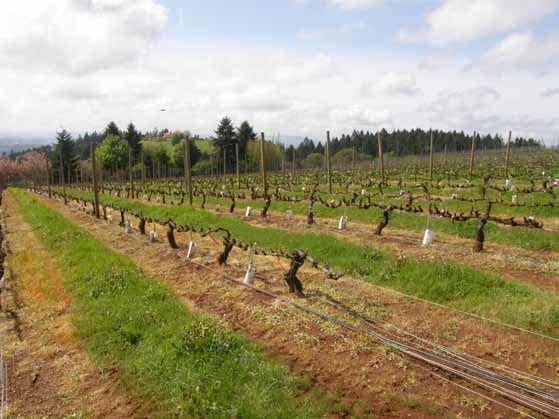
White Rose Vineyard was planted to Pommard clone on its own roots between 1978 and 1982. (There are
some new interplantings evident in the photo above) The east-southeast facing vineyard planted in volcanic
Jory soils is well-placed with several prominent producers nearby including Archery Summit, Domaine Serene,
and Domaine Drouhin Oregon. The vineyard sits at 870 feet elevation. The location is ideal, allowing an
extended growing season that lends itself to harvest in late October. This allows for slow phenolic
development, balanced sugars and acids, and mature stems. Greg has called his vineyard, “One of the ten
best vineyards in the New World.”
An adjacent 4 acres were acquired in 2009, planted to Dijon clone 115 grafted to American rootstock, and
named the Guillen Vineyard after Jesus Guillen who has managed the White Rose Vineyard since 2002 and
his son, also named Jesus Guillen, who is Greg’s winemaker. Greg also sources fruit from a number
of Willamette Valley’s top growers in the Yamhill-Carlton District, Dundee Hills, and Chehalem Mountains
appellations.
Greg is largely a self-taught winemaker (he prefers the term “producer”) who made his first wine in 1999 and
his first commercial White Rose Vineyard Pinot Noir in 2001. His winemaking production has evolved slowly
over the past 13 years tied to the emotional connection he has with wine. Since 2011, he has embarked on a
program that he terms “The Neo-Classical Objective.” It is a highly innovative approach for the Willamette
Valley and somewhat polarizing in its theory. Greg does not consider it revolutionary since it is soundly based
in Old World winemaking techniques. My following words paraphrase Greg’s philosophy.
There are two parts to The Neo-Classical Objective: the “why” and the “how.” The “how” is the more simple
part, the “why” more difficult to elucidate but is the impetus, so let me start with that first. Simply put, neoclassical
refers to an alternate presentation of wine that elevates “pinotnoirness” above everything else. The
word classic refers to the many presentations of pinotnoirness over multiple generations. The first requirement
to achieve the neo-classical objective is to have an old vine vineyard. Vines must be old enough to make an
age worthy wine. There must have enough phenolic and tannin components to outlast the process of oxidation
over time. Tannins cannot be overriding initially as the wine will be austere initially, requiring years to oxidize,
often reaching an acceptable level at the time the phenolics (fruit flavors) have dissipated.
The vineyard must be in the correct location, produce quality fruit and be subject to the proper temperature
such that the resultant wine can achieve a sense of pinotnoirness. In the classic sense, the grapes should
reach a state of crispness and freshness, preferably with raspberry and blackberry flavors. Greg gives the
following analogy. If you randomly pick nine cherries and put them in the palm of your hand, three will be dark
and concentrated (very ripe), three will be crisp and fresh, and three will be lean and tart. The most desirable
cherries for a classic driven Pinot Noir are the crisp and fresh ones. Thus, the timing of the picking decision is
critical.
The “neo” term in “neo-classical” incorporates the “how” in The Neo-Classical Objective. Greg’s current
approach to handling fruit, skin and seed tannins both in the vineyard and in the winery. Too little tannin and the
wine will not last, and too much tannin leads to an edgy wine initially that takes years to resolve the tannins. In
past generations, the tannins in wines could be overwhelming initially, something Greg avoids completely. The
ultimate objective is to have a wine that is good from day one and that will undergo metamorphosis over time,
not becoming necessarily better, but different.
Ideally, Greg wants much of the skin tannins to oxidize away on the vine at the same time as the grape
phenolics reach ideal ripeness (tannins are antioxidants, so as they diminish, the available oxygen that results
can ripen the phenolics). Invariably, some tannin remains at harvest, but he picks at a time he can manage the
astringency. In the cellar, punch downs are avoided to prevent rupture of berries and the release of harsh, bitter
seed tannins into solution (gentle punch overs are employed instead). Post-fermentation, the must is pressed
off using a laborious old world basket press. In addition, post-fermentation maceration is minimized, again to
avoid extracting too much additional tannin. Seed tannins take forever to oxidize and by then the fruit in the
wine is gone. The must is gently pressed off using a manual old world basket press that avoids breakage of
seeds and stems. The wines are barreled down in French oak for about 15 months, racked once after
malolactic fermentation, and then again just before blending. The wines are bottled unfined and unfiltered.
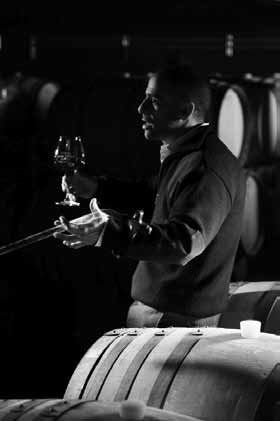
Greg’s Pinot Noirs produced from old vines in the neo-classical objective mode, are fermented 100% whole
cluster. He is not the least bit worried about the stems, only the flavor, phenolic intensity and tannins. In some
years, tannin management is not ideal, and some mild herbaceous character may creep in, which may not
appeal to all Pinot Noir drinkers. Still, Greg is undaunted, for the nuances, texture and haunting aromas and
flavors, and age ability associated with whole cluster fermentation are too advantageous to him.
In summary, to achieve the neo-classical objective of pinotnoirness and present the varietal in a manner such
that it has the greatest potential to generate an emotional connection to the wine:
1) Farm an old vine Pinot Noir vineyard planted to quality clones or selections appropriate for the site.
2) The vineyard must be located in the proper microclimate as growing temperatures dictate success.
3) Pick the grapes for crispness and freshness and modest tannic astringency.
4) Gently handle the fruit in the winery with efforts devoted to avoid excessive extraction of tannin, particularly
seed tannin.
5) Use 100% whole cluster fermentation.
6) Press the must manually with a basket press.
7) Minimize new oak.
Greg has expended considerable effort in improving the grounds of his property, the tasting room, and the
winery so it will connect with people’s emotions and the “White Rose experience.” The tasting room is unique
in that it has no windows do distract the visitor from the wines. In the cellar, elaborate mood lighting creates a
striking atmosphere, and all the barrels are uniformly sanded for an engaging appearance.
When I recently visited, Greg was at home in Orange County, California (he spends considerable time in
Oregon at his winery as well). I was hosted by assistant winemaker Jesus Guillen (right) and manager Gavin
Joll shown in front of the winery’s tasting room entrance. The winery and cellar is located underneath the
tasting room. We tasted through some of the 2011 and 2012 vintage White Rose Estate Pinot Noirs and I came
away with profound respect for Greg’s accomplishments.
I found the wines displayed haunting floral and exotic spice aromas and flavors associated with 100% whole
cluster ferments, with no herbaceous character evident in any of the wines. For me, and many other wine
enthusiasts, whole cluster aromatics are like “catnip for humans.” The wines also had structure yet elegance,
and modest, well-integrated tannins. All the wines could be enjoyed now. I would encourage readers to
experience these wines for their unique qualities. A number of Oregon wineries are experimenting with some
whole cluster inclusion in the manner of 10% to 30%, with an occasional 100% whole cluster bottling. Other
than Cristom Vineyards and Thomas Geerie Wines, there is no other Oregon winery that I know of other than
White Rose Estate that is fully committed to whole cluster vinification.
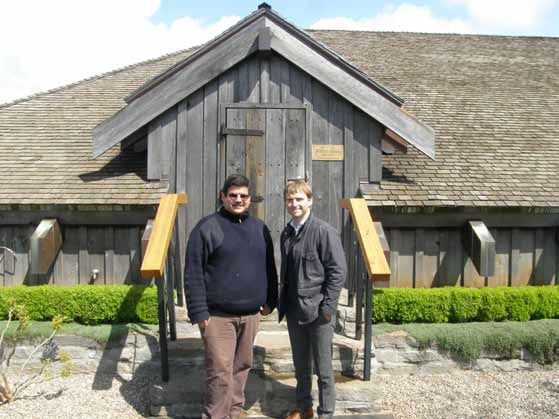
Greg’s comments on the 2012 vintage indicated excitement. Greg does not recall a vintage that has shown as
much potential. “The 2012 vintage was reminiscent of 2002 and 2008. It was warmer than average and
certainly warmer than the cooler vintages of 2007, 2010 and 2011, but cooler than the really warm vintages of
2003, 2006 and 2009. While the wines are dense and rich on the palate, they are extremely well balanced with
sufficient acidity. Unlike the warmest vintages where the fruit takes on an over ripe, stewed character, the
wines from 2012 consistently retain a fresh, vibrant sense of fruit. Retaining this freshness is critically
important to our winemaking goals at White Rose. It certainly appears that 2012 will live up to the hype.”
Located at 6250 NE Hilltop Lane in Dayton, the tasting room is open daily from 11 to 5 P.M.. Tours are
available by appointment. The wines are sold through a mailing list and on the website:
www.whiteroseestate.com. The Explorer’s Club offers unique bottlings. In 2012, wines were offered from
different elevations. In 2013, different clonal bottlings from the same vineyard will be offered. The Neo-
Classical Club includes wines that are collectable and age worthy.
2011 White Rose Estate “The Neo-Classical Objective” Willamette Valley Pinot Noir
13.0% alc., 416
cases, $80. Sourced from White Rose Vineyard (35%), Vista Hills Vineyard (31%), (Dundee Hills AVA, planted in
1999-2001 with clones 115 and 777), and Murto Vineyard (34%, Dundee Hills AVA, planted 1988-2005,
Pommard, 2A and 115). 100% whole cluster fermentation. Skin contact 23-25 days. Basked pressed with
wooden ratchet press. Aged 16 months in 9% new French oak.
·
Moderately light reddish purple color in the
glass. Highly perfumed with enticing aromas of cherry, wilted rose, exotic spices and the faintest oak. Bright
and juicy with light to mid weight flavors of well-spiced black cherry backed by modestly astringent tannins and
lively acidity. Very likable with a slight earthy bent to the flavors.
Score: 91-92

2011 White Rose Estate White Rose Vineyard Willamette Valley Pinot Noir
13.0% alc., 442 cases,
$95. Latest harvest ever, November 4-5. Made from selected mature vines. 5-day average cold soak.
Fermented 100% whole cluster. Total skin contact 25 days. Aged 16 months in 13% new French oak
barrels.
·
Moderately light reddish purple color in the glass. Distinctive whole cluster aroma featuring an
array of exotic spices, a floral display, and a compliment of sweet oak. Light to mid weight flavors of
black cherry and raspberry with plenty of spice and a kiss of oak. The finish is noticeably juicy and
persistent. Overall, the impression is one of harmony and enthralling brightness.
Score: 93-94
2012 White Rose Estate Willamette Valley Pinot Noir
13.2% alc., pH 3.63, 1,094 cases, $40. Released
May 2014. Harvest October 11-27. A blend of 9 vineyards. Pommard and Dijon 777, 115, 114 and 667. 73%
whole cluster on average. Aged 11 months in 11% new French oak.
·
Moderately dark reddish purple color in
the glass. Subdued, but pleasant, with dark fruit, baking spice and oak aromas. Middleweight, juicy flavors of
plum, black cherry and blackberry wrapped in modest tannins, finishing dry and with a succulent charge of fruit.
Score: 88-89
2012 White Rose Estate Guillén Vineyard Willamette Valley Pinot Noir
13.8% alc., pH 3.70, 188 cases,
$70. Fall release. Harvest Oct 17 and 24 with 1.5 tons per acre yield. 9-day cold soak, 21-22 day skin contact,
100% whole cluster fermentation, aged 16 months in 19% new French oak.
·
Moderate reddish purple hue in
the glass. Haunting aromas of black raspberry jam, dark rose petals, tea, incense and baking spices.
Admirable balance with a discreetly concentrated core of black raspberry and black cherry fruits accented with
spice. A bit reserved at this stage, but showing considerable potential. The strong finish has commendable
length.
Score: 92-93

2012 White Rose Estate Anderson Family Vineyard Willamette Valley Pinot Noir
13.0% alc., pH 3.71, 118 cases, $90. Released.
Harvest October 11, yield 1.7 tons per acre. Self-rooted Dijon 115.
100% whole cluster fermentation. 9-day cold soak, 26 days total skin
contact, aged 16 months in 10% new French oak.
·
Moderate reddish
purple color in the glass. Voluptuous, persistent aromatic pleasures
including black cherry, spice and wilted rose. Boldly concentrated plum
and black raspberry flavors are vibrant on the attack, showing numbing intensity
as well on the huge finish. The tannins are supportive but not intrusive. Despite
its sappy load, the wine has an elegant, polished mouth feel.
Score: 94-95

2012 White Rose Winemaker’s Cuvée Willamette Valley Pinot Noir
13.6% alc., pH 3.62, 257
cases, $90. Released. A special cuvée from winemaker Jesus Guillen who choses his favorite barrels
in the cellar. A blend of White Rose, Guillen, Vista Hills, Luciole and Red Hills vineyards. Vineyards
planted 1978-2006 primarily in Jory soils. Harvest Oct 11-26. 93% whole cluster fermentation on
average. 6-9-days cold soak. 20-26 days skin contact. Aged 16 months in 9% new French oak.
·
Moderate reddish purple hue in the glass. Fabulous nose perfumed with aromas of black cherry, black
raspberry, dark rose, exotic spices and peppery herbs. A terrific, well-structured wine in a masculine
style (jesus prefers this) with layers of flavors including Bing cherry, black raspberry pie filling, sassafras and
cola. The fine-grain tannins are nicely integrated and the finish is generous and satisfying.
Score: 93-94

2012 White Rose Estate “The Neo-Classical Objective” Willamette Valley Pinot Noir
13.6% alc., 428 cases, $80. Fall release. After
meticulously tasting barrel samples blind before bottling, only vineyards
that meet the neo-classical objective for a given vintage are selected for
this blend. White Rose Vineyard (11%), Vista Hills Vineyard (11%),
Anderson Family Vineyard (17%), Guillen Vineyard (28%), Lia’s
Vineyard (22%), and Luciole Vineyard (11%). Pommard, Wädenswil,
777 and 115. Harvest Oct 11-26. 100% whole cluster fermentation. Total skin
contact 16-26 days. Aged 16 months in 14% new French oak.
·
Medium reddish
purple hue in the glass. The nose is shy initially, opening slowly to reveal scents
of fresh dark berries, spice and cut flowers. Much more elegantly styled with a satisfying core of black
raspberry, plum and black cherry flavors expansive on the palate and generating a lengthy, spice-laden finish
highlighted by sweet oak and suave tannins.
Score: 93-94

2012 White Rose Estate White Rose Vineyard Willamette Valley Pinot Noir
12.9% alc., pH 3.77, 235 cases, $125. Fall release. Harvest
Oct 26-27. Yields only 0.5 tons per acre due to poor set. Self-rooted
Pommard. 100% whole cluster fermentation. 6-day cold soak, total skin
contact 20-21 days, aged 16 months in 10% new French oak.
·
Moderately light reddish purple color in the glass. Well-perfumed with hitone
aromas of cherry, raspberry, baking spices and sandalwood.
Gorgeous fruit core replete with striking flavors of fresh red and black
raspberries and exotic spices. Structured for the long haul with an amazingly
long, peacock tail finish. This wine typifies the neo-classical objective of
juiciness and freshness with enough tannic backbone to age and a minimum of oak intrusion to allow the fruit
to clearly speak.
Score: 95-96





